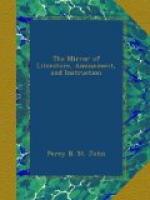[1] Published by Messrs. Moon, Boys and Graves Booksellers, Pall Mall.
* * * * *
MRS. HEMANS.
(To the Editor.)
In No. 550, of The Mirror, in some account of Mrs. Hemans, by The Author of a Tradesman’s Lays, it is erroneously stated that Mrs. Hemans is a native of Denbighshire. She was born in Liverpool, and was the daughter of Mr. George Brown, of the firm of Messrs. George and Henry Brown, extensive merchants in the Irish trade. Mr. Brown removed with his family, from Liverpool, to near Abergele, North Wales, where he resided some years. He married a Miss Wagner, daughter of Paul Wagner, Esq., a German, and a respectable merchant in Liverpool. Mrs. Hemans’s early poems were published by subscription in 1808; they were beautifully printed in quarto, at the press of the late Mr. John McCreery,[2] who long resided in Liverpool. Mrs. Hemans, after her marriage, lived near St. Asaph, with her mother and brother, Sir Henry Brown; after which she took up her residence at the village of Wavertree, three miles from Liverpool.
Liverpool.
A constant Reader.
[2] Mr. McCreery left Liverpool
to reside in London, he died a
short
time since of cholera, at Paris.
* * * * *
SPONTANEOUS COMBUSTION.
(To the Editor.)
The remarks of your Correspondent, A. Booth, in No. 567, of The Mirror, with respect to what is generally called “Spontaneous Combustion,” are very just. My present object is to show that the term “spontaneous” as applied to the subject in question, is incorrect. Mons. Pierre Aimee Laire, in an “Essay on Human Combustion from the abuse of Spirituous Liquors,” states that it is the breath of the individuals coming in contact with some flame, and being thus communicated inwardly, that is the cause of the combustion, and therefore it cannot be spontaneous; and he cites several instances of persons addicted to spirituous liquors being thus burnt. Moreover, it is stated that an anatomical lecturer, at Pisa, in the year 1597, happening to hold a lighted candle near a subject he was dissecting, on a sudden set fire to the vapours that came out of the stomach he had just opened. In the same year, as Dr. Ruisch, then anatomical professor at Pisa, was dissecting a woman, and a student holding a candle to give him light, he no sooner opened the stomach than there issued a yellow, greenish flame. Also at Lyons, in dissecting a woman, the stomach was no sooner opened than a considerable flame burst out and filled the room. This has been accounted for by experiments made by Dr. Vulpari, anatomical professor at Bologna. He affirms that any one may see, issuing from the stomach of an animal, a matter that burns like spirits of wine, if the upper




